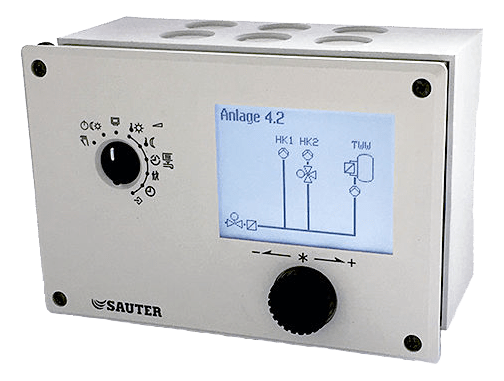Product search
Choose the category
Building Management System Cloud Services Electric drives, control valves, butterfly valves ON/OFF controllers Pneumatic drives, valves Pneumatics Sensors and transducers Stand-alone controller
Select the subcategory
Communication and networks Engineering (CASE) HVAC automation HVAC automation modulo 6 Managment level (software) Operation and indication Room automation System integration Digital Services Operation 6 -way ball valves Butterfly valvesmixing valves Electric drives Regulating valves combined with drive Smart Actuators Unit valves and drives Valveco - Regulating Valve VAV compact controllers Frost monitors Humidistats Pressure switches Thermostats Accessories Pneumatic drives Regulating valves combined with drive Accessories centair controller system Individual-room controlsystems, VAV Installationof pneumatic systems Relays and magnetic valves Air quality, AIQ, Other values Flow, VAV Humidity Pressure, differential pressure Temperature Thermowells equitherm heating controllers flexotron controllers for ventilation and a/c Intelligent unitary control: equiflex and VAV Intelligent unitary control for underfloor heating
Select the product
Wireless interface, EnOcean, ecosCom581
Web server for moduWeb Vision and moduWeb500 BACnet networks
Vision Services
viaSens Smart Sensor
VAV compact controller for laboratory and pharmaceutical applications
VAV compact controller
Valve actuator with spring return
Valve actuator with SAUTER Universal Technology (SUT)
Valve actuator with SAUTER Universal Technology (SUT)
Valve actuator
Valve actuator
Valve actuator
Valve actuator
Universal thermostat
Universal Contr. flexotron800 V2
Touch room operating unit, ecoUnit365
Time-lag relay
Tight-sealing butterfly valve, PN 16
Thermowells
Thermal actuator for unit valves with stroke indicator
SUT valve actuator with spring return
SUT valve actuator with spring return
SUT valve actuator with positioner
SUT valve actuator
Specially designed pressure limiter
Smart Actuator for ball valve
Smart Actuator for ventilation dampers
Smart Actuator for 2- and 3-way valves
SAUTER Vision Center
SAUTER Engineering Tools
SAUTER EMS and EMS Mobile
Sash sensor
Router, novaNet291
Rotary actuator with spring return for control ball valves
Rotary actuator with spring return and positioner
Rotary actuator with SAUTER Universal Technology (SUT) for ball valve
Rotary actuator with positioner
Rotary actuator for ball valve
Rotary actuator
Room-temperature transducer
Room transducer, relative humidity and temperature, surface-mounted
Room transducer, relative humidity and temperature
Room transducer, CO2 , surface-mounted
Room transducer, CO2 , surface-mounted
Room transducer, CO2 , recessed
Room transducer, air quality, surface-mounted
Room transducer, air quality, surface-mounted
Room temperature sensor, surface-mounted
Room temperature sensor, recessed
Room sensor, EnOcean, ecoUnit110
Room operating unit, EnOcean, ecoUnit146
Room operating unit, ecoUnit355
Room operating unit, ecoUnit310...316
Room humidistat
Room controller, ecos311
Room automation station, ecos504/505
Retrofit actuator
Retrofit actuator
Remote I/O module, ecoLink527
Remote I/O module, ecoLink522, 523
Remote I/O module, ecoLink514, 515
Remote I/O module, ecoLink510...512
Push-button unit for room operating unit, ecoUnit358
Push-button unit for room operating unit, ecoUnit306
Push-button unit for EnOcean room operating unit, ecoUnit106
Pressure-relieved 2-way flanged valve, PN 25 (pn.)
Pressure-relieved 2-way flanged valve, PN 25 (el.)
Pressure-reducing station
Pressure transmitter
Pressure switch
Pressure monitors and pressure switches
Power supply, DIN rail, 230 V / 24 VDC
Power supply unit
Position alarm/transmitter
Pneumatic volume-flow controller
Pneumatic volume-flow controller
Pneumatic valve actuators
Pneumatic valve actuator
Pneumatic temperature transducer for duct fitting, centair
Pneumatic sash sensor
Pneumatic room-temperature controller
Pneumatic room-pressure controllers
Pneumatic relay, pluggable
Pneumatic positioner
Pneumatic manual switch
Pneumatic line restrictor
Pneumatic humidity transducer for wall fitting
Pneumatic humidity transducer for duct fitting
Pneumatic air-volume transducer
Pneumatic actuator
Pneumatic actuator
Pneum. duct-temperature controller
Pneum. control-pressure adjuster (small cap.)
Pieces for push-on pneum. meas. lines
PI-controller
Panel-mounted humidistat (packing unit: 50 pieces)
P+PI cascade controller
P-controller
P-controller
Outdoor-temperature transducer
Outdoor temperature sensor
Operating and indicating unit for I/O modules, modu600-LO
OPC server
novaNet-Ethernet interface, moduNet292
novaNet-BACnet application master, moduNet300
Motorised actuator with positioner
Motorised actuator for unit valves with positioner
Motorised actuator for unit valves with positioner
Motorised actuator for unit valves
Motorised actuator
Module for separated I/O module supply, modu601‑LC
Modular BACnet automation station, modu660-AS
Modular BACnet automation station and web server, modu680-AS
Modular automation station, modu524/525
Modbus/RTU (RS‑485) communication module, modu620‑CM
Modbus fan coil thermostat
Mobile Building Services (MBS)
Material for pneumatic equipment
Manometer for indicating measured values
M-Bus communication module, modu630‑CM
Local operating unit, modu840
Local operating and indicating units, modu625...670
IP coupler for I/O modules, with web server, modu612‑LC
Instructions for pneumatic plants
I/O module, universal inputs, modu532
I/O module, digital outputs (relays), modu550
I/O module, digital inputs/outputs (open collector), modu571
I/O module, digital inputs, modu531
I/O module, analogue outputs, universal and digital inputs, modu572
I/O module for smart actuators
High-speed rotary actuator with SAUTER Universal Technology (SUT) for ball valve
High-speed damper actuator with SAUTER Universal Technology (SUT)
Heavy-duty, pneumatic control-pressure
Heavy-duty pressure switch
Heating controller with digital user interface, equitherm
Heating and district heating controller, equitherm
Heating and district heating controller, equitherm
Fume-cupboard indicator and monitor
Frost monitor/limiter with capillary sensor
Frame for device inserts with 55 × 55 mm fitting dimensions
Flow probe for ventilation ducts
Fan-coil room-temperature controller, with digital display
Fan-coil room-temperature controller, heating/cooling sequence
Fan-coil room-temperature controller, electromechanical
Energy DataLogger for EMS
Energy Data Logger für EMS
Energy Data Logger for EMS
Electropneumatic relay
Electronic room thermostat for heating and heating/cooling with display
Electronic room thermostat for heating and heating/cooling
Electronic power control unit
Electronic controller for simple applications, flexotron400
Electric distributor for positioning signals
Electric distributor for control signals
e/p and p/e converter
Dynamic flow control system with 6-way ball valve, eValveco
Dynamic flow control system with 2-way valve and energy monitoring, eValveco
Dynamic flow control system with 2-way or 3-way valve and energy monitoring, eValveco
Duct-mounted humidistat
Duct transducer, relative humidity and temperature
Duct transducer, enthalpy
Duct transducer, CO2 and temperature
Duct transducer, air quality (VOC), temperature
Duct temperature sensor
Dual-channel air-volume controller
Digital Services – Remote Management
Digital Services – Customer Portal
Differential pressure transmitter
Differential pressure transducer
Differential pressure switch
Differential pressure controller/transducer, centair
Dew point monitor and transducer
Damper control unit
Damper actuator with spring return and positioner
Damper actuator with spring return and positioner
Damper actuator with spring return
Damper actuator with spring return
Damper actuator with SAUTER Universal Technology (SUT)
Damper actuator with SAUTER Universal Technology (SUT)
Damper actuator
Damper actuator
Damper actuator
Coupling kit for I/O modules in cabinet, modu602‑LC
Control valve with threaded connection, PN 10
Control valve with flange connection, PN 6
Continuous thermal actuator for unit valves with stroke indicator
Continuous frost monitor with capillary sensor
Communication module with M-Bus and EIA-232 interfaces, modu731
Communication module with EIA-232 and EIA-485 interfaces, modu721
Clamp-on temperature sensor
CASE Suite
Cable temperature sensor
BACnet router and SC hub, B/IP <-> B/SC, modu630-RT
Averaging relay
Average-temperature transducer
Air-volume adding relay
Air-flow transducer
8 x AO and 8 x DI/CI I/O module, modu671-IO
8 × UI (DI/CI/AI), 8 × DI/CI I/O module, modu631-IO
8 × DI/CI/DO (OC) and 8 × DI/CI I/O module, modu670‑IO
6-way ball valve with male thread, PN 16
6 × relay (2A) outputs I/O module, modu650‑IO
4 × AO, 4 × DO(OC), 4 × UI (DI/CI/AI) I/O module, modu672‑IO
3-way valve with male thread, PN 16
3-way valve with female thread, PN 16 (pn.)
3-way valve with female thread, PN 16 (el.)
3-way unit valve, PN 16 (el.)
3-way unit valve, PN 16
3-way unit valve, PN 16
3-way regulating ball valve with male thread, PN 40
3-way regulating ball valve with female thread, PN 40
3-way flanged valve, PN 40 (el.)
3-way flanged valve, PN 6 (pn.)
3-way flanged valve, PN 6 (el.)
3-way flanged valve, PN 6
3-way flanged valve, PN 40 (pn.)
3-way flanged valve, PN 25/16 (pn.)
3-way flanged valve, PN 25/16 (el.)
3-way flanged valve, PN 16/10 (pn.)
3-way flanged valve, PN 16/10 (el.)
3-way flanged valve, PN 16
3-way changeover ball valve (T) with male thread, PN 40
3-way changeover ball valve (T) with female thread, PN 40
3-way changeover ball valve (L) with female thread, PN 40
2-way valve, PN 16
2-way valve, PN 16
2-way valve with male thread, PN 16
2-way valve with female thread, PN 16 (pn.)
2-way valve with female thread, PN 16 (el.)
2-way regulating valve for dynamic hydronic balancing, PN 25, Valveco compact
2-way regulating valve for dynamic hydronic balancing, PN 16, Valveco flange
2-way regulating ball valve with male thread, PN 40
2-way regulating ball valve with female thread, PN 40
2-way flanged valve, PN 40 (el.)
2-way flanged valve, PN 6 (pn.)
2-way flanged valve, PN 6 (el.)
2-way flanged valve, PN 6
2-way flanged valve, PN 40 (pn.)
2-way flanged valve, PN 25/16 (pn.)
2-way flanged valve, PN 25/16 (el.)
2-way flanged valve, PN 16/10 (pn.)
2-way flanged valve, PN 16/10 (el.)
2-way flanged valve, PN 16
2-way cut-off ball valve with male thread, PN 40
2-way cut-off ball valve with female thread, PN 40
16 × DI/CI inputs I/O module, modu630-IO
Room transducer, relative humidity and temperature, recessed


